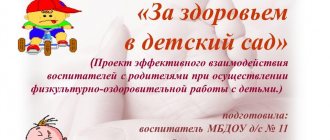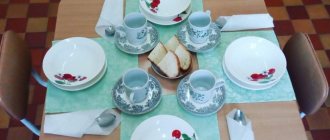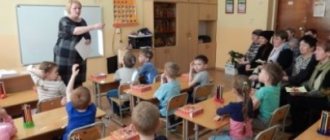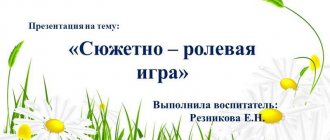Goals and objectives of health-saving technologies in the senior group of preschool educational institutions
The practical implementation of the concept of educational, health-improving, corrective and preventive measures, implemented through the interaction of children, their parents, teachers and kindergarten medical staff, is called health-saving technology. This concept covers different aspects of the development of a child’s personality: physical growth, character formation, including in the aspect of developing a strategy for relationships with others and with oneself. All these components of the system of educational activities with children of the senior group are aimed at:
- organizing conditions to maintain the maximum level of health of pupils (this applies, first of all, to the environment in which children are located - all its elements must be absolutely safe for preschoolers);
- formation of ideas about the highest value of the health of the baby himself and the people around him (including through training to adhere to measures to prevent unforeseen situations in everyday life);
- obtaining ideas about ways to lead a healthy lifestyle (HLS), for example, through familiarization with different methods of hardening, healthy nutrition systems, etc.;
Children study any aspects of a healthy lifestyle in theory, but in practice they implement only those that are approved by their parents.
- developing skills of correct behavior in emergency situations (for example, providing first aid for bruises or household injuries).
In the context of a teacher’s professional activity, the implementation of health-preserving techniques is aimed at:
- enriching personal experience with healthy lifestyle culture skills (for example, in terms of increasing one’s own stress resistance in the workplace);
- providing parents of pupils with materials related to the practical implementation of the fundamentals of health theory, that is, increasing their valeological competence.
This is interesting. Taking into account the focus of work on health-saving technologies, all aspects of educational activities are considered from the standpoint of interaction with children and close contact with parents.
The objectives of the health-saving direction of educational work are formulated for four types of health-saving technologies practiced in kindergarten.
Table: tasks of types of health saving technologies for the older group
| Technology | Content | Tasks for the senior group |
| Health and fitness | Improving physical qualities (strength, endurance, flexibility) and providing conditions to satisfy the need for movement. |
|
| Medical preventive | Providing timely preventive measures aimed at maintaining health under the supervision of preschool medical staff. |
|
| Technology for providing conditions for maintaining the socio-psychological well-being of children (work on this technology is carried out by a teacher in active collaboration with a psychologist through tests and observations) | Searching for optimal conditions for children to be emotionally comfortable in kindergarten, as well as conducting diagnostic measures designed to determine how ready the child is for the next educational stage. |
|
| Valeology educational (aimed, among other things, at working with families of pupils) | Introducing mothers and fathers to the basics of a healthy lifestyle, as well as ways to foster a culture of health in the family. |
|
This is interesting. One of the relatively new technologies for maintaining health in preschool educational institutions, practiced only in a number of kindergartens in the country, is the method of V.F. Bazarny. Its essence lies in the fact that children are provided with a regime of changing poses to prevent disorders of the musculoskeletal system. During classes, preschoolers not only sit at tables, but also stand at special desks with an inclination angle of up to 18 degrees. In addition, educational activities of a direct nature are organized in the “visual horizons” mode: visibility is located away from the children on “rockers” suspended from the ceiling, the supports of which are located in the four corners of the room. And also in the process of GCD, the method involves training on a special ophthalmic simulator: children, at the direction of the teacher, “run” with their eyes a bright trajectory on the ceiling, combining movements of the eyes and head.
Photo gallery: technical support for Bazarny’s methodology
Using desks helps avoid problems with the musculoskeletal system
Training on an ophthalmic simulator maintains visual acuity
Visual materials, according to Bazarny, should be located under the ceiling: this is how children preserve their eyesight while studying
Health-saving technologies in primary school lessons with presentation
Health-saving technologies in primary school
Author of the project: Anna Aleksandrovna Znakomova, primary school teacher, State Budgetary Educational Institution Secondary School No. 32 named after L.V. Bobkova [1]. Preserving the health of children is one of the most important functions of the school. It is important that children receive theoretical knowledge about maintaining health and be able to use it practically. A child is our continuation, our love, faith and hope, our daily work and hard work. Yes, it’s work, because for the health of the child you need to work hard. Only a set of health promotion measures rationally carried out by the joint efforts of parents and teachers can help a child maintain health. [2]. “Caring for health is the most important work of a teacher. Their spiritual life, worldview, mental development, strength of knowledge, self-confidence depend on the vital activity and vigor of children...” Vasily Aleksandrovich Sukhomlinsky [3]. Relevance Health is the most important factor in the performance and development of a child’s body. The child has gone to school, which means his body must reorganize in order for his studies to be successful. The fundamental basis for the full and harmonious development of a person is her physical and spiritual development. [4]. Contradictions - Inconsistency of teaching methods and technologies with the age and functional capabilities of schoolchildren; — Lack of a mechanism for introducing the principle of a healthy lifestyle into mass practice; — Due to the unsatisfactory level of their physical development, many primary school students have difficulty mastering educational material. [5]. Problem - Formation of the necessary knowledge, skills and habits of a healthy lifestyle in younger schoolchildren, using the acquired knowledge in everyday life. [6]. Object of study Health-saving teaching technologies in primary school Subject of research Health-saving teaching aids as a “foundation” for the intellectual and creative superstructure of the individual in lessons in primary school [7]. Hypothesis - The effectiveness of the educational process is largely determined by the degree to which the physical and psychological characteristics of students are taken into account. [8]. Goal : Creating conditions for the intellectual and creative development of the personality of younger schoolchildren based on their awareness of the value of a healthy lifestyle. [9]. Objectives - To create needs for a healthy lifestyle; — Contribute to the preservation and strengthening of the child’s health, the creation of a favorable environment in the classroom; — To help every child realize their abilities, to create conditions for their further development. [10]. Project participants - Students of grades 2a and 2b - Parents - Nurse - Implementation period - 1 year [11]. Stages of project implementation I. Analytical includes: 1. Preparatory. Studying the problem. (September 2014) 2. Diagnostic. Questionnaires, monitoring, interviews to identify children’s abilities and children’s knowledge about healthy lifestyles. (October 2014) II. Practical. Achieving the set goal and solving the assigned tasks. (November-March 2014/15) III. Final. Analysis of the results obtained. (March 2020) [12]. Expected results - Prevention of fatigue and fatigue; — Increasing motivation for educational activities; — Increase in educational achievements. [13]. Results of introductory diagnostics Children's academic performance level: Average - 31.2%; Sufficient - 36.4%; High - 32.4% Quality of knowledge - 68.8% Achievement - 100% [14]. Means of health-saving educational technologies in the lesson - physical education minutes - wellness minutes - minutes of relaxation - breathing exercises - eye gymnastics - color therapy - finger gymnastics - massage of active points - use of musical means (V. Krutitsky, R. Schumann, P. Tchaikovsky) - Walks on fresh air [15 – 17] - physical education for a minute in elementary school [18]. Color therapy Game – colored dreams. (the game may be accompanied by an oral description of the slides by the teacher to a pleasant melody) [19]. Yellow – stimulates mental activity; [20]. green – pacifies, calms; [21] blue – lowers blood pressure, calms; [22]. blue – disposes to seriousness, severity in behavior; [23]. purple – stimulates the activity of the heart and lungs, increases the body’s resistance to colds; [24]. black in a small dose – focuses attention [25] . Results of the final diagnostics Children's academic performance level: Average - 22.2%; Sufficient - 37.8%; High-40% Quality of knowledge - 77.8% Achievement - 100% [26]. You can observe the dynamics of growth in the level of academic achievement [27]. The result of the project is to improve the quality of knowledge and the level of preparedness of students; — stabilization of child morbidity rates, improvement of the psychological climate in the team; — positive dynamics in the level of health-preserving activities; — increasing the number of participants in various competitions; — positive assessment of work experience at the school level. [28]. Conclusion Correctly selected means of health-saving education allowed not only to improve the quality of knowledge, but also contributed to the formation of the need for a healthy lifestyle among students. The hypothesis was confirmed. [29]. Weight of briefcases for primary school students On average, an empty briefcase weighs 500 - 700 g, a briefcase with textbooks - 2,600; 4,200; 4,300; 4,500 g. And the briefcase with sports uniform weighs 3,500; 4,900 g [30-32]. Active recreation in nature is the best way to restore strength and relieve fatigue. The annual summer camp “Rainbow” has become a tradition of our school. Only last year the camp was a health camp, but now we are just a day camp. But as before, we organize outdoor celebrations, the “Sand Castles” competition, “Robinsonades”, “Pirate Holidays”, “Spartakiads” and other exciting holidays. Slide numbers are indicated in square brackets.
Presentation on the topic: Health-saving technologies in primary school lessons
We recommend watching:
Physical education programs for the prevention and correction of various diseases among students Physical education minutes in school lessons Health-saving technologies in history and social studies lessons Health-saving children in additional education
Similar articles:
Health-saving technologies for children with disabilities (hearing impairment) in elementary school
Application of health-saving technologies in primary school





